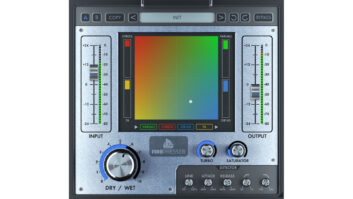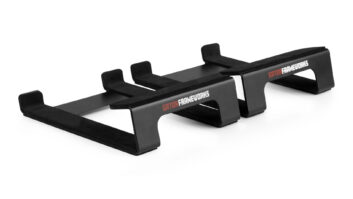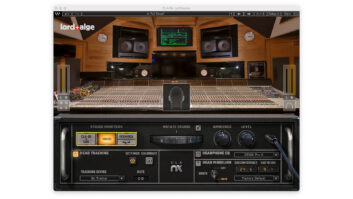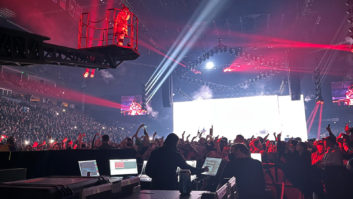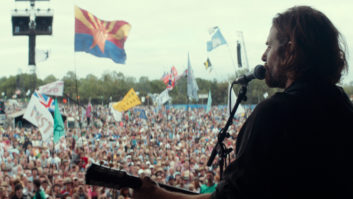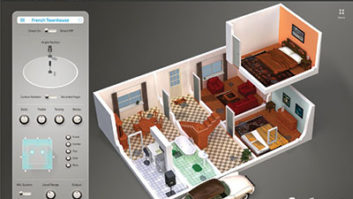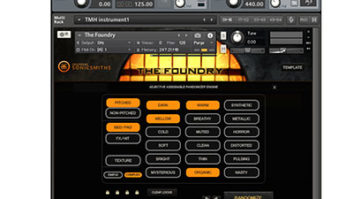
The recording industry is filled with paradoxes. We’re excited about new technologies, but tend to avoid the bleeding edge of breakthroughs that might be here today, discarded tomorrow. Yet audio pros have never been afraid to embrace the future, and the past three decades marked an era of enormous technological upheaval in professional audio. In many ways, 1977—when Mix was born—proved an extremely significant year in technology, and that revolution continues to this day.
With that in mind, we revisited 10 major movements that shaped pro recording. These are listed in no particular order, because selecting one as more important than another would be just plain silly, and listing them in an exact chronological sense is impossible, as the revolution is still underway. So, here are our Top 10 picks.
Yamaha NS-10s were the perfect “real-world” reference for many pro mixers.
NEAR-FIELD MONITORS
Smallish reference speakers (such as Auratones) did exist before 1977, but during that year Ed Long’s Calibration Standard Instruments introduced the MDM-4 Near Field Monitor™ with its then-revolutionary concept of near-field speakers. Back then, no one could have predicted the impact his Near Field Monitor would have on studios for decades to come. A year later, Yamaha debuted the NS-10—a compact bookshelf speaker. Although a failure with consumers, it eventually found favor among studio users as a reference comparable to small home hi-fi’s and decent car stereos. Later products, such as the Meyer HD-1 and Genelec 1031, took the near-field approach to wide acceptance as serious audio tools.

Abbey Road Studios technical director Ken Townsend (right) jokingly hands his Visa card over to SSL founder Coline Sanders as a down payment on a 4000-Series console.
THE BIG BOARDS
At AES Paris in 1977, SSL introduced its 4000A Series console with onboard “Studio Computer,” and the race was on, with automation—mostly VCA-based, but also moving fader systems—eventually becoming a common sight on the studio landscape. The first large-scale digital console—the Neve DSP—appeared in 1982, but it wasn’t until a decade later that Capricorn, Neve’s commercial digital console, arrived. Yet analog showed no signs of letting go, whether it was 1984’s TAC Scorpion (only $6,000!), Neve’s 1986 mega-hit V Series or Harrison’s Series 10/12, with digital-controlled automation of all functions. The digitally controlled analog concept also found lasting success in the 1988 Euphonix Crescendo.
Everything changed in 1995, with Yamaha’s compact 02R digital 8-bus, offering 40 inputs on remix, along with moving faders, instantaneous reset, dynamics on every channel and onboard effects processors—all for $10,000. Meanwhile, the onscreen power of DAWs and the increasing popularity of mixing “in the box” drove the need for combination console/workstation controllers, from smaller Yamaha boards to SSL’s large-format Duality. The market wasn’t unnoticed by Digidesign, which began a long-term controller development project in the late 1990s, leading to its ProControl, Control 24, and eventually ICON and VENUE products. Today, the market is wide open, with consoles both small and large—analog, digital, DAW controllers and hybrids with any/all of the above.

Frank Zappa with his PCM-3324 in his Utility Muffin Research Kitchen studio, flanked by Sony’s Toshi Doi (left) and Curtis Chan (right). Zappa was an early adopter of digital recording.
DIGITAL TAPE
In 1977, analog multitracks were well-established, with 2-inch decks from Ampex, MCI, Otari, Scully, Stephens, Studer and 3M and smaller-format machines from Fostex, Tascam, Otari and Dokorder. A year later, 3M showed its $115,000 digital machine that recorded 32 tracks (16-bit/50kHz) on 1-inch tape at 45 ips. Mitsubishi countered with its own 32-track PD (ProDigi) format shared by Otari. And with Sony’s DASH (Digital Audio Stationary Head) ½-inch 24-track standard supported by Matsushita, MCI, Studer and Tascam, the format wars were off and running. The arguments over the “best” format were short-lived, but the DASH standard emerged as the winner, helped mainly by the development of the $240,000+ dual-density DASH decks that recorded 48 tracks on that same ½-inch tape and could also play sessions from their digital 24-track cousins.
Neither the PD nor DASH 2-track machines gained much ground, with most studios finding that mixing to analog 2-track offered sonic advantages over the all-digital pathway. What did catch the attention of pros was 1987’s consumer DAT digital tape format. It was convenient and fairly inexpensive, but was embroiled in years of RIAA attempts to legislate copy-code circuits to prevent home CD taping. Years later, consumer DAT decks (equipped with SCMS—Serial Copy Management System) arrived, but by then, DAT failed as a home format, with the net effect of SCMS making it difficult for bands using home digital equipment to create back-up copies of their own works.
These days, 2-inch analog is used less as a recording medium, but has enjoyed a resurgence as an effects device for recording rhythm tracks, and later transferring to a disk-based workstation for overdubs, editing and mixing.

Early CDs’ labor-intensive manufacturing made replication plants expensive and scarce.
THE CD COMETH
The 1982 advent of the CD wrought a convenient, novel and decent-quality medium into the hands of consumers, but also ushered profound changes into the pro audio community. This newfound format required entirely different production, mastering and replication methods. Suddenly, premastering and tape editing services sprung up as a new industry, while phrases like “PQ coding,” “normalization,” and “1610 master” became part of the lingo. And the price of a CD plant in the early 1980s was simply astronomical—unlike a vinyl pressing business, the cost of a replication facility was beyond the means of the average business.
On the creative side, CD mastering bore little resemblance to the disk mastering, with all the nuances of dealing with groove pitch and depth and working with the RIAA disk equalization curves. In the studio, the CD actually opened up new possibilities. With no side A/B hassles, tracks could be recorded of any length—even extending beyond the LP’s usual 40-minute limit. And mixing for CD was an anything-goes affair: bass-heavy signals could be panned anywhere in the soundstage—something that would never occur on a vinyl release. Yet years later, the convention for center-panning bass guitar and kick drum remains. Old habits die hard.

In 1984, New York City’s Unique Recording earned the name “MIDI City.”
MIDI
MIDI (Musical Instrument Digital Interface) wasn’t the first sequencing platform for electronic musical instruments. But as a non-manufacturer-specific standard, it’s remarkable that it still exists and thrives today—some 24 years after its birth. MIDI’s origins stem from Sequential Circuits founder (and Prophet-5 synth designer) Dave Smith, who presented a 1981 AES paper for a Universal Synthesizer Interface based on his meetings with Tom Oberheim and Roland’s Ikutaro Kakehashi.
In a rare example of insight and cooperation, competing companies worked together to refine USI into the more powerful MIDI standard, culminating in a public demonstration of MIDI at Winter NAMM 1983. As computers became affordable and more powerful, MIDI became a staple in studios, along with growing racks of synths, drum machines, sequencers and samplers, with control rooms expanding to house all of this gear. During the ensuing years, the original MIDI spec was enhanced with features such as MIDI sample dump, MIDI Time Code, MIDI Show Control, MIDI Machine Control, General MIDI and incorporating MIDI sequencing into the DAW environment.
Opcode shook the world with Studio Vision (1990), a digital audio sequencer that combined MIDI sequencing with the digital audio capability of Digidesign’s Sound Tools. Audio data showed up as tracks of waveforms and could be cut/pasted/manipulated as easily as MIDI tracks in a conventional sequencing program. The concept caught on, and other digital sequencers, such as MOTU’s Digital Performer, Steinberg’s Cubase Audio, Emagic’s Logic Audio and Cakewalk Audio, entered the market.

Housed in a 40-pound suitcase, the TEF System-10 had 96kB of RAM, a 9-inch, green-phosphor screen and a $14,500 price tag, but kicked off a revolution in acoustics in 1983.
ACOUSTICS COME ALIVE
It would be ridiculous to infer that decent acoustics didn’t exist prior to 1983. But the early days of facility design were driven mostly by intuition, a modicum of luck and a great deal of trial-and-error experimentation—very expensive when you’re building rock walls. All that changed in 1983 when Crown’s Techron division unveiled the TEF System 10, the first portable Time Delay Spectrometry analyzer/acoustical measurement system. Licensed using Richard Heyser’s 1967 TDS concepts, the TEF (Time-Energy-Frequency) included energy-time curves and the ability to show complex waterfall displays of audio spectra, allowing, for the first time, complex on-site measurements of systems and spaces from a commercially-available product.
At the time, available acoustical materials were few—mostly absorptive devices such as heavy drapes, perforated cellulose wall/ceiling tiles, pumice-like stone tiles, fabric-covered Fiberglas batting and a few brands of foam. Coincidentally, as the TEF 10 came to market, acoustician Dr. Peter D’Antonio formed RPG Diffusor Systems, Inc., offering his Reflection Phase Grating (RPG) products, which were capable of turning what would have been a hard reflected sound into a controllable diffuse field. Combined with traditional absorption methods, D’Antonio’s diffusion gratings brought a new dimension to acoustical treatment. This, along with the TEF’s ability to measure the effects of sounds striking various surfaces (including consoles) inaugurated the era of modern, science-based studio design.

EMT’s Model 250 was the first digital reverb, but at $20,000 and three-feet-tall, it wasn’t cheap or compact. The first under-$1,000 reverbs wouldn’t arrive until nearly a decade later.
AFFORDABLE DIGITAL REVERBS
Traditionally, realistic-sounding artificial reverb was never easy or cheap. Acoustic chambers required a lot of real estate and just the right design—a tricky proposition. EMT introduced the concept of the plate reverb in 1957—still fairly large, but at least far smaller and less expensive than a chamber. In 1976, EMT built the Model 250—the first commercial digital reverb—but at $20,000 (and nearly three feet tall) it wasn’t exactly cheap or compact. Lexicon’s 1978 Model 224 was more affordable—only $7,400. It had a four-rackspace “brain” (still not petite), but only two programs—expandable to four programs for an extra $400. Other reverbs followed, including the 224X, 224XL, the AMS rmx-16, Quantec Room Simulator, and Eventide’s SP-2016—the first effects box to offer new sounds via third-party DSP “plug-ins” on interchangeable ROM chips—but 1984’s Lexicon PCM60 set a new price mark as the first pro digital reverb under $1,500.
A year later, the first under-$1,000 reverbs debuted from two companies spun off from the breakup of MXR: ART’s $995 DR2 had seven room types, while the Alesis XT reverb offered two programs at $795. In 1986, Yamaha launched the SPX90, a $745 unit that even today is standard item in studio and touring racks. Affordable outboard DSP had finally arrived.

Alesis CEO Russell Palmer (at right) and staff watch the first ADATs arrive in 1992.
THE PROJECT STUDIO
The term “project studio” has its origins back in the late ’70s, with companies promoting the analog ½-inch 8-track format, which bridged the gap between hobby and full-on pro recorders. With careful attention to gain structure, machines like Tascam’s 80-8 and the Otari 5050B-8 could certainly produce decent work. In the late ’80s, both Fostex and Tascam were offering very good sounding ½-inch 16-tracks, thanks to Dolby S-type noise reduction, a consumer version of its pro Spectral Recording system. And linked to MIDI tracks with a simple FSK sync box, a semi-pro 8- or 16-track rig was capable of nearly anything.
In 1989, newcomer Mackie Designs debuted the CR-1604, a 16-channel mixer, but in an all-metal chassis with an internal power supply and seven aux sends per channel. The concept of a rugged, clean-sounding, affordable console took the industry by surprise, and the process repeated three years later with Mackie’s 8•Bus line, with a 24-channel, 8-bus mixer priced less than $4,000.
A major revolution began on January 18, 1991, when Alesis launched the ADAT, a Modular Digital Multitrack system offering 8-track digital recording on S-VHS tapes, with the ability to interlock multiple transports for up to 128 tracks. The original ADAT was $3,995—a lot for a digital 8-track in today’s terms—but compared to the $100,000+ reel-to-reel digital 24-tracks of its time, ADAT was a bargain. Although ADAT was still 14 months away from delivery, it had the effect of immediately bringing analog 8/16-track recorder sales to a halt. Affected most by ADAT’s arrival, Tascam and Fostex began their own MDM development projects. Alesis went on to sell more than 100,000 ADATs, and digital multitracking was no longer the realm of the rich and famous.

Roger Linn introduced programmable drum machines with sampled osunds in 1980 with the LM-1, followed by his later LinnDrum (shown) and MPC60 designs.
LOOP RECORDING/SAMPLING
One of the weak links in any home/budget recording was always drums. In 1980, Roger Linn introduced the LM-1 Drum Computer—the first programmable drum machine with sampled sounds. With its realistic-sounding drums, the LM-1 (and its later cousin, the LinnDrum) was an instant success, even at $4,995. The term “drum machine” became part of the language, and jobs sprang up for drum machine “programmers.” Other drum machines followed, and with MIDI sequencing, drum editing became easier than ever. Sampling drum machines with onboard sequencing, such as the E-mu SP12 and Akai’s MPC60 (and others to follow), opened up an entire world of music production to both players and non-traditional music creators.
Once described as the “ultimate tool for sampled grooves,” Steinberg ReCycle (designed by Propellerhead Software) kicked off the software revolution in 1994, followed by programs such as Sonic Foundry’s ACID (1999) Propellerhead’s Reason (2000) and Ableton’s Live (2001), offering tools for looping. Interestingly, while these began as specialized applications for looping functions, some—like ACID and Live—later became more DAW-like. Meanwhile, the more traditional DAW programs—such as SONAR, Cubase, Logic, Digital Performer and Pro Tools—eventually responded to the market by adding more loop production features.

The new studio: a Mac II, a MIDI synth, a JLCooper MixController, a Les Paul and a Pro Tools rig
THE RISE OF THE DAW
The digital audio workstation represents the single most significant development in the history of digital pro audio. Yet from the earliest commercial software and 8-bit D/A cards for the Apple II back in 1977 from Micro Technology Unlimited—the real evolution of the workstation was tied to the development of personal computer technology.
Digidesign wasn’t the first DAW, but its launch of Pro Tools in 1991—priced from $5,995, a fraction of the $100,000-plus New England Digital Direct-to-Disk systems it competed with—created a stir that continues to this day. By 1994, third-party plug-ins caught on with non-audio apps such as Photoshop. Soon, companies such as Waves, Jupiter Systems and Arboretum Systems began developing software add-ons for DAWs. Eventually, the market exploded, with more companies and more supported platforms, including TDM, MAS, VST, DirectX, RTAS and Audio Units. Signal processing hasn’t been the same since.
Modern workstations combine high resolution and diversity, with a multitude of companies supplying components, both hardware (I/O devices, converters, console-style controllers and peripherals) and software. The latter, of course, defines the new horizons of workstation art and science, with ever more powerful CPUs, and applications, plug-ins and virtual instruments taking every imaginable form. Ironically, the DAW—once an editing adjunct to the studio—in many cases today has become the studio.
TURNING IT UP TO 11
So far, we’ve talked about 10 movements that changed pro recording, but we’d be remiss to ignore one that isn’t tied to any single technology—the concept of long distance collaboration. In the old days, shipping 2-inch analog masters was a risky proposition, but digital tape made it much safer; T1 phone lines, fiber optics and satellite uplinks made it possible; and eventually, broadband Internet made it convenient.
In 1991, Skywalker Sound was using Dolby AC-2 coding to move ADR files between its Northern and Southern California facilities. That technology was spun off into EDnet, which Phil Ramone used for the production of Frank Sinatra’s 1993 Duets album. With ADAT or DA-88 MDM digital tapes, making an 8-track slave tape (with a guide mix and seven tracks for overdubs) was just a FedEx envelope away. By the mid-’90s, companies such as the Rocket Network were using the Internet as courier, although the accessibility of broadband was somewhat dodgy a decade ago, to say the least. These days, with fast Internet, there are few limitations for doing almost anything long distance. It’s a whole new world—although it’s shrinking by the minute.
